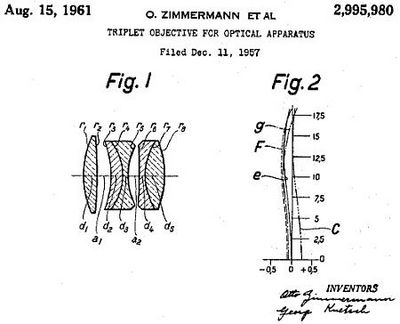Otto Zimmermann: Difference between revisions
From Leica Wiki (English)
Jump to navigationJump to search
mNo edit summary |
mNo edit summary |
||
| Line 1: | Line 1: | ||
[[File:Ozim.jpg]] [[File:B20.JPG]] | [[File:Ozim.jpg]] [[File:B20.JPG|400px]] | ||
" . . . Leica always had the obtainment of the best possible optical glasses for its M lenses as one aim of paramount importance, and the examples are manifold: the thorium oxide glass nD= 1,69112 vD= 54, 8 included in four of the lenses of the optical formula of the Leitz Summitar* [[Summicron (I) f= 5 cm 1:2]] Original Project 1950 designed by [[Gustav Kleinberg]] and [[Otto Zimmermann]] (which also had a flint lead-glass plate to avoid film fogging by radiation) . . ." '''Source''' - [http://elrectanguloenlamano.blogspot.com/2008_06_01_archive.html José Manuel Serrano Esparza] | " . . . Leica always had the obtainment of the best possible optical glasses for its M lenses as one aim of paramount importance, and the examples are manifold: the thorium oxide glass nD= 1,69112 vD= 54, 8 included in four of the lenses of the optical formula of the Leitz Summitar* [[Summicron (I) f= 5 cm 1:2]] Original Project 1950 designed by [[Gustav Kleinberg]] and [[Otto Zimmermann]] (which also had a flint lead-glass plate to avoid film fogging by radiation) . . ." '''Source''' - [http://elrectanguloenlamano.blogspot.com/2008_06_01_archive.html José Manuel Serrano Esparza] | ||
Revision as of 14:12, 13 March 2012
" . . . Leica always had the obtainment of the best possible optical glasses for its M lenses as one aim of paramount importance, and the examples are manifold: the thorium oxide glass nD= 1,69112 vD= 54, 8 included in four of the lenses of the optical formula of the Leitz Summitar* Summicron (I) f= 5 cm 1:2 Original Project 1950 designed by Gustav Kleinberg and Otto Zimmermann (which also had a flint lead-glass plate to avoid film fogging by radiation) . . ." Source - José Manuel Serrano Esparza
E. Leitz Photographic Patents by Otto Zimmermann
- 1935 DEC 07 - PHOTOGRAPHIC VIEW FINDER
- 1938 DEC 13 - PHOTOGRAPHIC VIEW FINDER (see above)
- 1950 JUL 20 - PHOTOGRAPHIC OBJECTIVE LENS SYSTEM (8 / 6) with Gustav Kleinberg (see Summicron (I) f= 5 cm 1:2)
- 1957 DEC 11 - TRIPLET OBJECTIVE FOR OPTICAL APPARATUS (5 / 3) with Georg Knetsch (see above)
- 1958 AUG 21 - PHOTOGRAPHIC OBJECTIVE (7 / 5) with Gustav Kleinberg and Eugen Hermanni
- 1961 APR 11 - WIDE-ANGLE LENS (9 / 7 - 8 / 6) with Heinz Marquardt, Hermann Desch and Eugen Hermanni (see 28mm f/2.8 Elmarit I)

